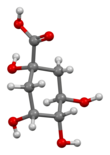Quinic acid
| |||
| Names | |||
|---|---|---|---|
| Preferred IUPAC name
(1S,3R,4S,5R)-1,3,4,5-Tetrahydroxycyclohexane-1-carboxylic acid | |||
| Identifiers | |||
3D model (JSmol)
|
|||
| ChEBI | |||
| ChEMBL | |||
| ChemSpider | |||
| ECHA InfoCard | 100.000.976 | ||
PubChem CID
|
|||
| UNII | |||
CompTox Dashboard (EPA)
|
|||
| |||
| |||
| Properties | |||
| C7H12O6 | |||
| Molar mass | 192.17 g/mol | ||
| Density | 1.35 g/cm3 | ||
| Melting point | 168 °C (334 °F; 441 K) | ||
| Hazards | |||
| GHS labelling: | |||
 [1] [1]
| |||
| Warning[1] | |||
| H319[1] | |||
| P264, P280, P305+P351+P338, P337+P313[1] | |||
| NFPA 704 (fire diamond) | |||
Except where otherwise noted, data are given for materials in their standard state (at 25 °C [77 °F], 100 kPa).
| |||
Quinic acid is a cyclitol, a cyclic polyol, and a cyclohexanecarboxylic acid. It is a colorless solid that can be extracted from plant sources. Quinic acid is implicated in the perceived acidity of coffee.
Occurrence and preparation
[edit]The compound is obtained from cinchona bark, coffee beans, and the bark of Eucalyptus globulus.[2] It is a constituent of the tara tannins.
Urtica dioica, the European stinging nettle, is another common source.[citation needed]
It is made synthetically by hydrolysis of chlorogenic acid. Quinic acid is also implicated in the perceived acidity of coffee.
History and biosynthesis
[edit]
This substance was isolated for the first time in 1790 by German pharmacist Friedrich Christian Hofmann in Leer from Cinchona.[3] Its transformation into hippuric acid by animal metabolism was studied by German chemist Eduard Lautemann in 1863.[4]
Its biosynthesis begins with the transformation of glucose into erythrose 4-phosphate. This four-carbon substrate is condensed with phosphoenol pyruvate to give the seven-carbon 3-deoxy-D-arabinoheptulosonate 7-phosphate (DAHP) by the action of a synthase. Two subsequent steps involving dehydroquinic acid synthase and a dehydrogenase afford the compound.[5]
Derived bicyclic lactones are called quinides. One example is 4-caffeoyl-1,5-quinide.
Dehydrogenation and oxidation of quinic acid affords gallic acid.[5]
Applications and medicinal activity
[edit]Quinic acid is used as an astringent.
This acid is a versatile chiral starting material for the synthesis of pharmaceuticals.[5] It is a building block in the synthesis of Oseltamivir, which is used to treat influenza A and B.
References
[edit]- ^ a b c d "D-(−)-Quinic acid Safety Data Sheet". Sigma-Aldrich.
- ^ Santos, Sónia A. O.; Freire, Carmen S. R.; Domingues, M. Rosário M.; Silvestre, Armando J. D.; Neto, Carlos Pascoal (2011). "Characterization of Phenolic Components in Polar Extracts of Eucalyptus globulus Labill. Bark by High-Performance Liquid Chromatography–Mass Spectrometry". Journal of Agricultural and Food Chemistry. 59 (17): 9386–93. doi:10.1021/jf201801q. PMID 21761864.
- ^ Hofmann: Crell's chemische Annal. 1790, II, p. 314, cited in S. Baup: Über die Chinasäure und einige ihrer Verbindungen. In: Annalen der Physik und Chemie 1833, p. 64–70 ([1], p. 64, at Google Books).
- ^ Lautemann, E. (1863) "Ueber die Reduction der Chinasäure zu Benzoësäure und die Verwandlung derselben in Hippursäure im thierischen Organismus" (On the reduction of quinic acid to benzoic acid and its transformation into hippuric acid in the animal organism), Annalen der Chemie, 125 : 9–13.
- ^ a b c Barco, Achille; Benetti, Simonetta; De Risi, Carmela; Marchetti, Paolo; Pollini, Gian P.; Zanirato, Vinicio (1997). "D(-)-Quinic Acid: a Chiron Store for Natural Product Synthesis". Tetrahedron: Asymmetry. 8: 3515–3545. doi:10.1016/S0957-4166(97)00471-0.
Further reading
[edit]- "Quinic acid - chiral compounds from nature - Buchler quinine plant in Braunschweig, Germany". Quinic acid. Retrieved September 5, 2005.
- "Quinic acid". Fast Health. Retrieved September 5, 2005.
- "History of Xenobiotic Metabolism". Archived from the original on April 12, 2005. Retrieved September 5, 2005.
- Ripley, George; Dana, Charles A., eds. (1879). . The American Cyclopædia.



